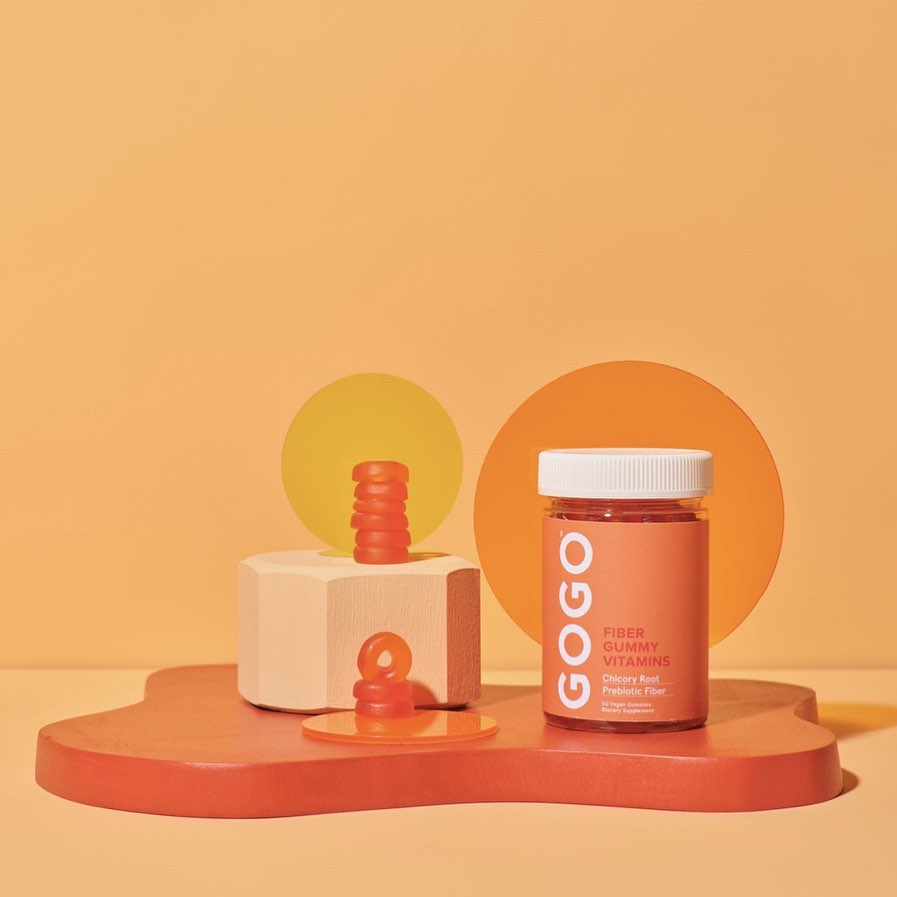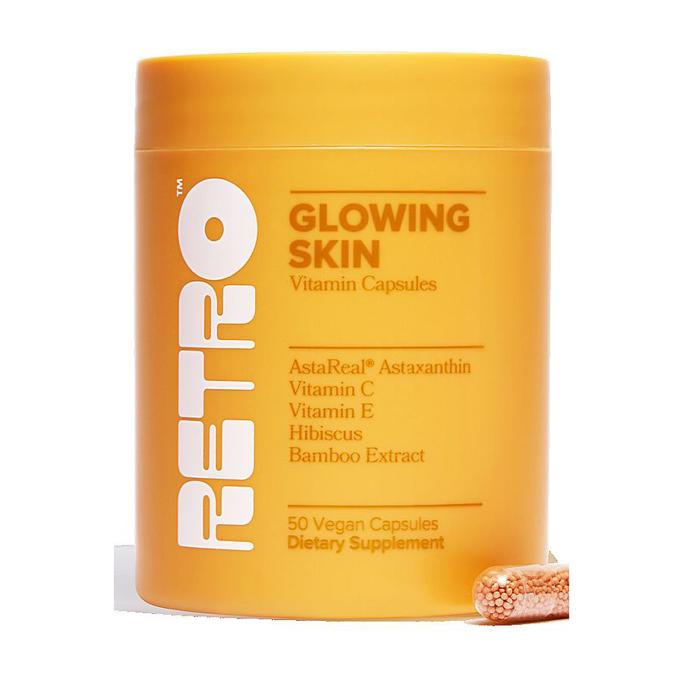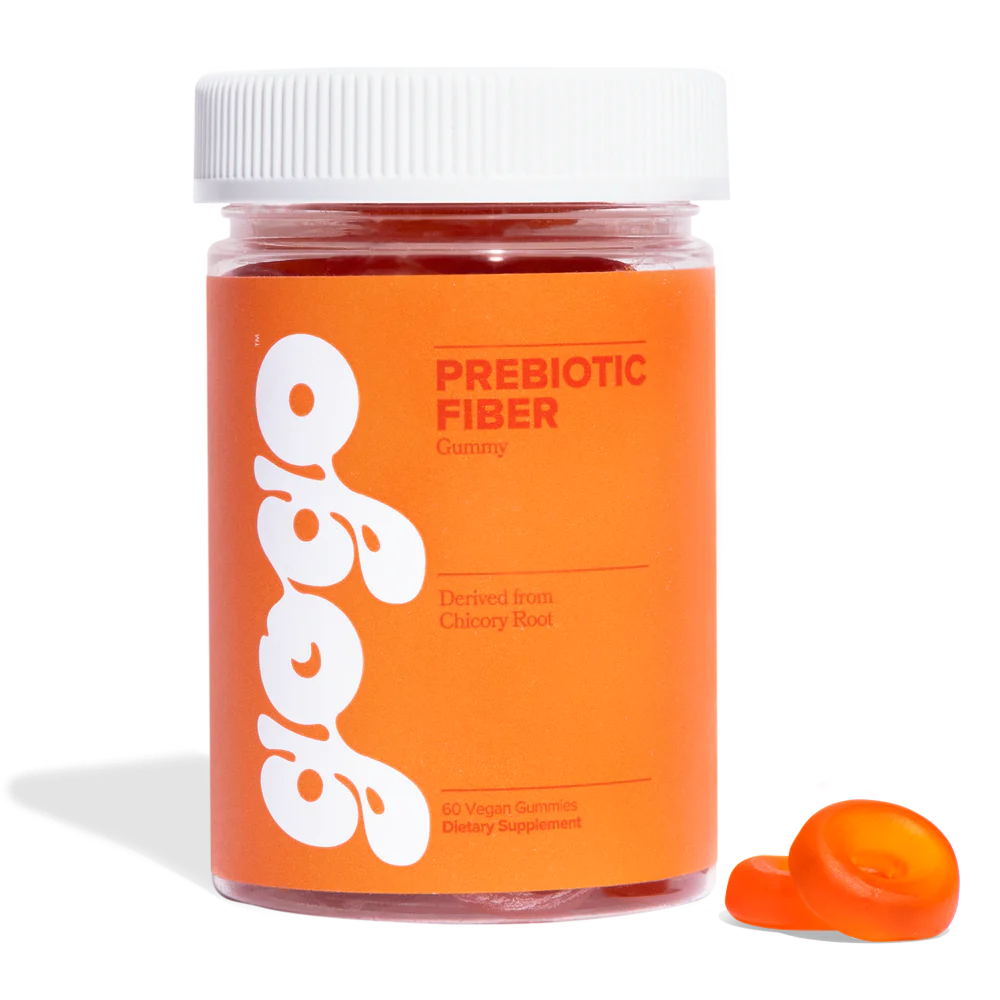Table of Contents
About Flo

Flo was founded in 2018 by siblings Brianna and Bobby Bitton. The duo wanted to start an important conversation about PMS and periods. Along the way, the company has empowered women to heal their bodies and minds.
FLO’s collection began with a PMS gummy, but it has since evolved over time to include fiber and immunity supplements.
The vitamins contain natural ingredients like chicory root, chaste berry, vitamin B6, and lemon balm—all conveniently packed into a simple gummy.
FLO PMS Gummy Ingredients

Chasteberry: Chasteberry is a popular herbal remedy that has a long history of use for women’s hormonal health. It contains compounds that act on the pituitary gland to support the production of hormones like progesterone, which can help regulate menstrual cycles, relieve menstrual cramps and reduce PMS symptoms.
Vitamin B6: Vitamin B6 is an essential vitamin that helps the body to metabolize proteins, carbohydrates and fats. It can also help to relieve symptoms of premenstrual syndrome, including irritability, breast tenderness, bloating and fatigue.
Dong Quai: Dong quai is an herb that has been used for centuries in traditional Chinese medicine to balance hormones and treat women’s reproductive health issues. It is believed to reduce cramps, bloating and irritability, as well as improve mood and fertility.
Lemon Balm: Lemon balm is an herb that has calming, antispasmodic and anti-inflammatory properties. It can help reduce PMS symptoms, such as irritability, insomnia, cramps and headaches. It can also help to reduce stress and improve mood.
FLO Glowing Skin Vitamin Capsule Ingredients

Flo Gummies Glowing Skin Vitamin Capsule
Astaxanthin: Astaxanthin is a powerful antioxidant that is found in a variety of natural sources such as algae, salmon, krill oil, and more. It has been shown to help protect against oxidative damage and support healthy inflammation levels. Astaxanthin is also believed to help promote glowing skin, as it helps to reduce the appearance of wrinkles, age spots, and other signs of aging.
Hibiscus: Hibiscus is a flowering plant that has been used for centuries in traditional medicine. It is rich in antioxidants and vitamins, including Vitamin C and Vitamin A.
Hibiscus helps to protect the skin from environmental damage and can help to reduce inflammation, which can lead to improved skin health and a glowing complexion.
Vitamin E: Vitamin E is an essential nutrient that is important for a healthy immune system and for maintaining healthy skin. It helps to protect the skin from environmental toxins and free radicals, and it can help to reduce the appearance of wrinkles and other signs of aging.
Vitamin C: Vitamin C is an essential nutrient that helps to protect the skin from environmental damage and can help to reduce inflammation. It also helps to stimulate collagen production, which helps to keep the skin looking firm and smooth.
Bamboo Extract: Bamboo extract contains a variety of vitamins, minerals, and amino acids that help to nourish and protect the skin.
It is rich in antioxidants and can help to reduce the appearance of wrinkles and age spots. Bamboo extract also helps to boost hydration levels in the skin, which can help to promote a healthy, glowing complexion.
FLO Prebiotic Fiber Gummy Ingredients

Fiber Derived From Chicory Root: Is a prebiotic fiber that helps promote digestive health. It is a type of soluble fiber that helps to slow digestion, which can help to regulate blood sugar levels and provide a feeling of fullness.
Chicory root fiber helps to feed the friendly bacteria in the gut, which may help to promote a healthy balance of bacteria in the gut. It can also help to reduce inflammation and support immune function.
Additionally, this prebiotic fiber has been found to have a positive effect on cholesterol levels.
FLO Disco Women’s Multi Gummy Vitamin Ingredients

Disco Women’s Multi Gummy is a dietary supplement designed for women looking to support their overall health and wellbeing. The product features a blend of 15 core vitamins and minerals essential for optimal health, as well as added adaptogens traditionally used for stress relief and cognitive function.
Ingredients List:
Adaptogens (Ashwagandha & Rhodiola): Adaptogens are plant-based substances that help the body adapt to physical and mental stress. Ashwagandha is an adaptogen that helps to reduce anxiety and fatigue and improve concentration, while Rhodiola is an adaptogen that helps to boost energy and brain function. Both of these adaptogens have numerous health benefits and can help to regulate hormones and support overall wellbeing.
Adaptogens are natural substances that help the body cope with stress and improve mental clarity. In addition, the gummies contain antioxidants, which are known to support the immune system and protect cells from damage caused by free radicals.
Disco Women’s Multi Gummy is a convenient and tasty way to ensure that women are getting the essential nutrients they need to feel their best every day.
DHA (Docosahexaenoic acid): Docosahexaenoic acid is an omega-3 fatty acid that is essential for brain and nervous system development. It has been shown to reduce inflammation, improve memory and cognitive function, and protect against age-related mental decline. It is also important for maintaining healthy skin, hair, and eyes.
Folate: Folate is a B vitamin that helps the body produce and maintain new cells. It is essential for proper brain development in infants and is important for DNA synthesis and repair. Folate helps to reduce the risk of birth defects and is important for energy production and red blood cell formation.
Biotin: Biotin is a B vitamin that helps the body convert food into energy. It is essential for healthy skin, hair, and nails, and it helps the body metabolize fats and proteins. Biotin also supports normal nerve and brain function.
Vitamin A: Vitamin A is a fat-soluble vitamin that is essential for maintaining healthy vision, skin, and immune function. It is found in foods such as liver, fish, eggs, and fortified dairy products. Vitamin A plays a crucial role in the formation of rhodopsin, a pigment in the retina that is important for vision in low-light conditions. It also helps maintain healthy skin by promoting cell growth and preventing dryness and flakiness. Additionally, Vitamin A is important for immune function and may help reduce the risk of infections.
Vitamin C: Vitamin C, also known as ascorbic acid, is a water-soluble vitamin that is important for maintaining healthy skin, bones, and connective tissue. It is found in many fruits and vegetables, including citrus fruits, kiwi, strawberries, and bell peppers. Vitamin C is an antioxidant that helps protect the body against damage from harmful free radicals. It also helps the body absorb iron from plant-based foods and plays a role in collagen synthesis, which is important for wound healing and skin health.
Vitamin D3: Vitamin D3, also known as cholecalciferol, is a fat-soluble vitamin that is important for maintaining strong bones and teeth. It is produced by the body when skin is exposed to sunlight and is also found in some foods, including fatty fish, egg yolks, and fortified dairy products.
Vitamin D3 helps the body absorb calcium and phosphorus, which are important minerals for bone health. It also plays a role in immune function and may help reduce the risk of certain diseases, including osteoporosis and some types of cancer.
Vitamin E: Vitamin E is a fat-soluble vitamin that is important for maintaining healthy skin, eyes, and immune function. It is found in many plant-based oils, such as sunflower, safflower, and almond oil, as well as in nuts, seeds, and leafy green vegetables.
Vitamin E is an antioxidant that helps protect the body against damage from harmful free radicals. It also plays a role in skin health by reducing inflammation and promoting wound healing.
Vitamin B1: Vitamin B1, also known as thiamine, is a water-soluble vitamin that is important for energy metabolism and nerve function. It is found in many whole grains, beans, nuts, and meat products.
Vitamin B1 helps the body convert food into energy and plays a role in nerve function by helping to maintain the myelin sheath, which is important for transmitting nerve impulses.
Vitamin B2: Also known as riboflavin, is a water-soluble vitamin that plays an essential role in energy metabolism, the breakdown of fats, carbohydrates, and proteins to produce energy.
It also acts as an antioxidant, helping to protect cells from damage caused by free radicals. Good food sources of B2 include dairy products, eggs, lean meats, green leafy vegetables, and fortified cereals.
Vitamin B3: Also known as niacin, is another water-soluble vitamin that plays a crucial role in energy metabolism, helping to convert food into energy. It also supports healthy skin, nervous system, and digestive system.
Additionally, niacin has been shown to help lower LDL cholesterol (bad cholesterol) levels and triglycerides, thereby reducing the risk of heart disease. Good sources of B3 include chicken, turkey, fish, peanuts, and whole grains.
Vitamin B6: Another water-soluble vitamin that plays a vital role in energy metabolism, helping to break down glycogen (stored carbohydrates) into glucose (usable energy). It also supports brain function, the immune system, and the formation of red blood cells.
Additionally, B6 is involved in the synthesis of neurotransmitters, such as serotonin and dopamine, which regulate mood, appetite, and sleep. Good sources of B6 include bananas, chicken, fish, potatoes, and fortified cereals.
Vitamin B12: Also known as cobalamin, is a water-soluble vitamin that plays a critical role in the formation of red blood cells, DNA synthesis, and nerve function. It is also involved in energy metabolism, helping to convert food into energy. Vitamin B12 is primarily found in animal-based foods such as meat, fish, and dairy products. Vegans and vegetarians may need to supplement their diets with B12 or consume fortified plant-based foods to meet their daily requirements.
Minerals Iodine, Zinc & Selenium: These minerals are essential for healthy growth, metabolism, and immune system. Iodine helps to produce hormones and keep the thyroid functioning properly. Zinc helps to create and repair cells and maintain a healthy immune system, and Selenium helps to protect the body from damage caused by free radicals.
References
Medically Cited: Our process involves examining medical research that has been published in reputable scientific journals, with the goal of upholding the highest possible standards of scientific accuracy.
Fact-Checked: To maintain quality, Repositive assigns a team of medical experts, including doctors and Registered Dietitians, to each article.
1. Mayo, J.L., Black cohosh and chasteberry: Herbs valued by women for centuries. Target, 1998. 19: p. 22-26. http://www.medicinacomplementar.com.br/biblioteca/pdfs/Doencas/do-2061.pdf
2. Rail, L.C. and S.N. Meydani, Vitamin B6 and immune competence. Nutrition Reviews, 1993. 51(8): p. 217-225. https://onlinelibrary.wiley.com/doi/abs/10.1111/j.1753-4887.1993.tb03109.x
3. Hirata, J.D., et al., Does dong quai have estrogenic effects in postmenopausal women? A double-blind, placebo-controlled trial. Fertility and Sterility, 1997. 68(6): p. 981-986. https://pubmed.ncbi.nlm.nih.gov/9418683/
4. Yui, S., et al., Beneficial effects of lemon balm leaf extract on in vitro glycation of proteins, arterial stiffness, and skin elasticity in healthy adults. Journal of Nutritional Science and Vitaminology, 2017. 63(1): p. 59-68. https://pubmed.ncbi.nlm.nih.gov/28367927/
5. Meephansan, J., et al., Effect of astaxanthin on cutaneous wound healing. Clinical, Cosmetic and Investigational Dermatology, 2017. 10: p. 259-265. https://www.ncbi.nlm.nih.gov/pmc/articles/PMC5516620/
6. Ismail, A., E.H.K. Ikram, and H.S.M. Nazri, Roselle (Hibiscus sabdariffa L.) seeds nutritional composition protein quality and health benefits. Food, 2008. 2(1): p. 1-16. https://www.semanticscholar.org/paper/Roselle-%28Hibiscus-sabdariffa-L.%29-seeds-nutritional-Ismail-Hainida/659ab4b0884447568f6dea5381a8396d11b051b0
7. Jamini, T.S. and A.A. Islam, Roselle (Hibiscus sabdariffa L.): Nutraceutical and pharmaceutical significance, in Roselle. 2021, Elsevier. p. 103-119. https://www.researchgate.net
8. Rizvi, S., et al., The role of vitamin E in human health and some diseases. Sultan Qaboos University Medical Journal, 2014. 14(2): p. e157. https://www.ncbi.nlm.nih.gov/pmc/articles/PMC3997530/
9. Pullar, J.M., A.C. Carr, and M.C. Vissers, The roles of vitamin C in skin health. Nutrients, 2017. 9(8): p. 866. https://www.ncbi.nlm.nih.gov/pmc/articles/PMC5579659/
10. Chongtham, N., M.S. Bisht, and S. Haorongbam, Nutritional properties of bamboo shoots: Potential and prospects for utilization as a health food. Comprehensive Reviews in Food Science and Food Safety, 2011. 10(3): p. 153-168. https://ift.onlinelibrary.wiley.com/doi/10.1111/j.1541-4337.2011.00147.x
11. Ramasamy, U.S., et al., Effect of soluble and insoluble fibers within the in vitro fermentation of chicory root pulp by human gut bacteria. Journal of Agricultural and Food Chemistry, 2014. 62(28): p. 6794-6802. https://pubs.acs.org/doi/abs/10.1021/jf501254z
12. Galo, A., Gummy bear vitamins. Journal (Canadian Dental Association), 2011. 77: p. b33-b33. https://europepmc.org/article/med/21507286
13. Pawar, V.S. and H. Shivakumar, A current status of adaptogens: Natural remedy to stress. Asian Pacific Journal of Tropical Disease, 2012. 2: p. S480-S490. https://www.sciencedirect.com/science/article/pii/S2222180812602072
14. Panossian, A.G., Adaptogens in mental and behavioral disorders. Psychiatric Clinics, 2013. 36(1): p. 49-64. https://www.psych.theclinics.com/article/S0193-953X(12)00104-9/abstract
15. Singh, N., et al., An overview on ashwagandha: A Rasayana (rejuvenator) of Ayurveda. African Journal of Traditional, Complementary and Alternative Medicines, 2011. 8(5S). https://www.ncbi.nlm.nih.gov/pmc/articles/PMC3252722/
16. Khanum, F., A.S. Bawa, and B. Singh, Rhodiola rosea: A versatile adaptogen. Comprehensive Reviews in Food Science and Food Safety, 2005. 4(3): p. 55-62. https://www.researchgate.net/publication/227507099_Rhodiola_rosea_A_Versatile_Adaptogen
17. Calder, P.C., Docosahexaenoic acid. Annals of Nutrition and Metabolism, 2016. 69(Suppl. 1): p. 8-21. https://www.karger.com/Article/Abstract/448262
18. Iyer, R. and S. Tomar, Folate: A functional food constituent. Journal of Food Science, 2009. 74(9): p. R114-R122. https://ift.onlinelibrary.wiley.com/doi/full/10.1111/j.1750-3841.2009.01359.x
19. Lipner, S.R., Rethinking biotin therapy for hair, nail, and skin disorders. Journal of the American Academy of Dermatology, 2018. 78(6): p. 1236-1238. https://www.jaad.org/article/S0190-9622(18)30204-4/abstract
20. Al Tanoury, Z., A. Piskunov, and C. Rochette-Egly, Vitamin A and retinoid signaling: Genomic and nongenomic effects. Journal of Lipid Research, 2013. 54(7): p. 1761-1775. https://www.jlr.org/article/S0022-2275(20)42126-1/fulltext
21. Pacier, C. and D.M. Martirosyan, Vitamin C: Optimal dosages, supplementation and use in disease prevention. Functional Foods in Health and Disease, 2015. 5(3): p. 89-107. http://www.ffhdj.com/index.php/ffhd/article/view/174
22. Di Rosa, M., et al., Vitamin D3: A helpful immuno‐modulator. Immunology, 2011. 134(2): p. 123-139. https://onlinelibrary.wiley.com/doi/full/10.1111/j.1365-2567.2011.03482.x
23. Kono, N. and H. Arai, Intracellular transport of fat‐soluble vitamins A and E. Traffic, 2015. 16(1): p. 19-34. https://onlinelibrary.wiley.com/doi/full/10.1111/tra.12231
24. Niki, E. and N. Noguchi, Dynamics of antioxidant action of vitamin E. Accounts of Chemical Research, 2004. 37(1): p. 45-51. https://pubs.acs.org/doi/abs/10.1021/ar030069m
25. Moskowitz, A. and M.W. Donnino, Thiamine (vitamin B1) in septic shock: A targeted therapy. Journal of Thoracic Disease, 2020. 12(Suppl 1): p. S78. https://cdn.amegroups.cn/journals/pbpc/files/journals/2/articles/34757/public/34757-PB1-2971-R2.pdf
26. Suwannasom, N., et al., Riboflavin: The health benefits of a forgotten natural vitamin. International Journal of Molecular Sciences, 2020. 21(3): p. 950. https://www.mdpi.com/1422-0067/21/3/950
27. Sauve, A.A., NAD+ and vitamin B3: From metabolism to therapies. Journal of Pharmacology and Experimental Therapeutics, 2008. 324(3): p. 883-893. https://jpet.aspetjournals.org/content/324/3/883.short
28. Gay, R. and S.N. Meydani, The effects of vitamin E, vitamin B6, and vitamin B12 on immune function. Nutrition in Clinical Care, 2001. 4(4): p. 188-198. https://onlinelibrary.wiley.com/doi/abs/10.1046/j.1523-5408.2001.00142.x
29. Domellöf, M., Microminerals: Iron, Zinc, Copper, Selenium, Manganese, Iodine, Chromium and Molybdenum. Nutritional Care of Preterm Infants, 2021. 122: p. 140-148. https://www.karger.com/Article/Abstract/514738
We’ve also broken down the ingredients of Goli Gummies and Alpha Brain for you to explore next.

Leave a Reply